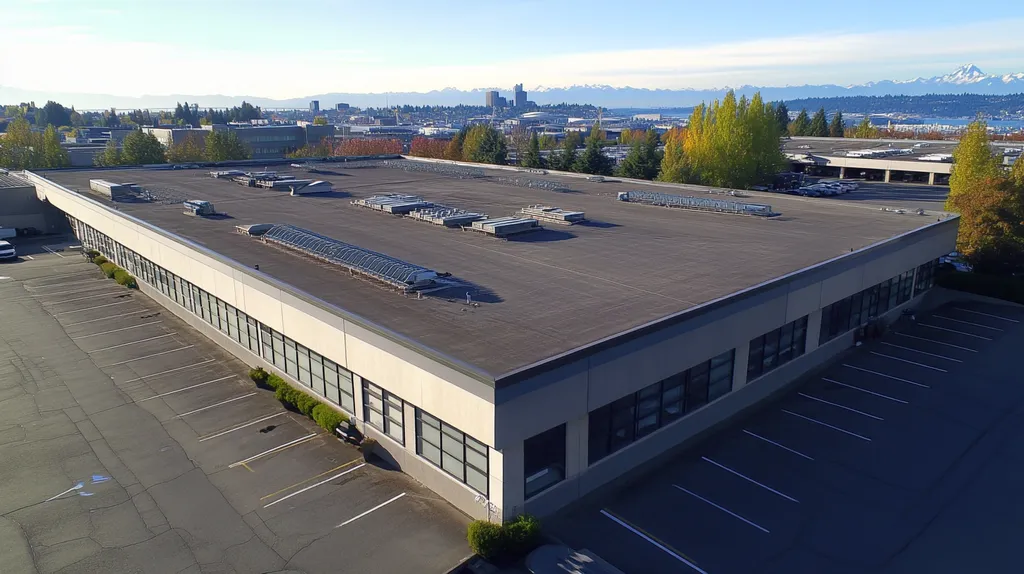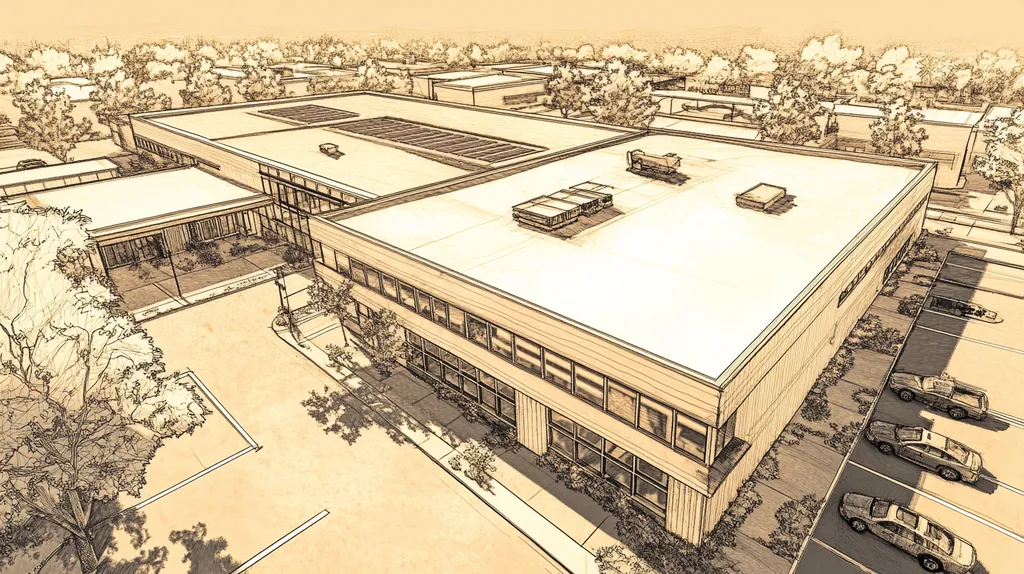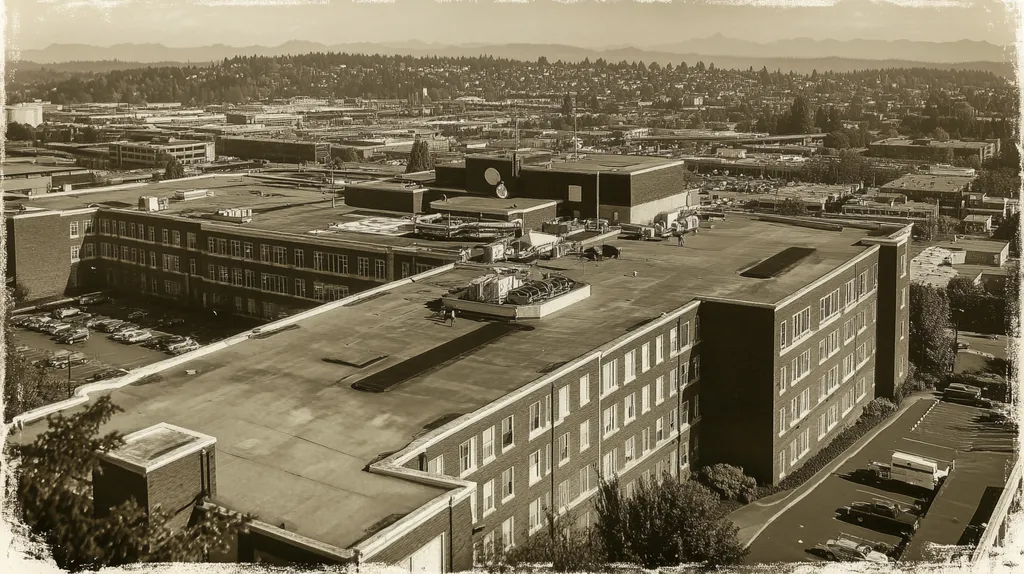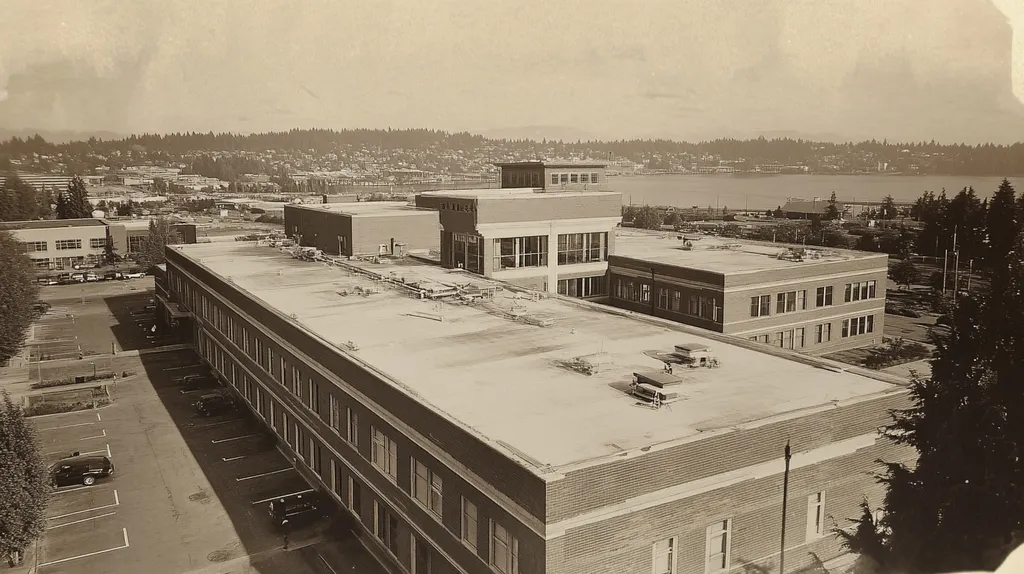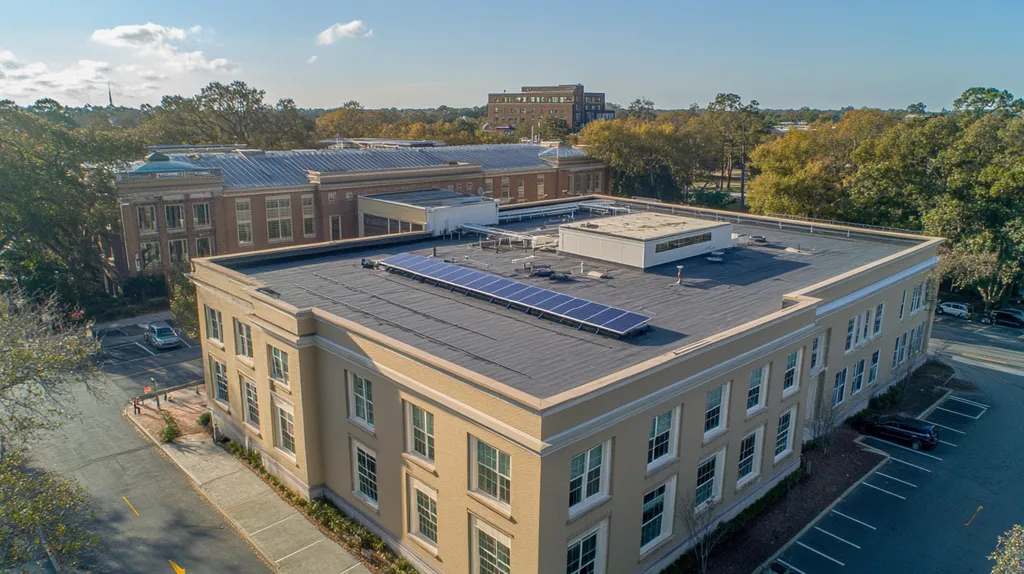Drainage failures account for over 40% of commercial roof replacements, resulting in billions of dollars in preventable damage annually across the United States. Despite decades of established practices, conventional drainage strategies continue to fall short of meeting modern building requirements.
From inadequate drain placement to obsolete design assumptions, traditional approaches ignore critical vulnerabilities that threaten both roof integrity and building operations.
This analysis challenges long-held drainage practices while examining systemic issues, missed opportunities, and data-driven solutions that could revolutionize commercial roof performance.
SECTION 1: CURRENT PRACTICES
Commercial roof drainage represents a critical yet often overlooked aspect of building infrastructure. Improper drainage management leads directly to premature roof failure, structural damage, and significant financial losses. While standard practices have evolved over decades, many conventional approaches fail to address the complex challenges of modern commercial buildings.
Common Drainage Components and Configurations
Over time, even minor drainage design flaws can lead to major roof deterioration, causing leaks, insulation damage, and structural compromise. Poor drainage typically stems from design oversights and inadequate maintenance, with issues commonly arising from insufficient drain placement and improper slope calculations. (source: MacDermott Roofing)
Primary drainage components include internal drains, scuppers, and perimeter gutters. These elements work together to channel water off the roof surface and away from the building structure. However, their effectiveness depends heavily on proper sizing, strategic placement, and regular maintenance.
Most commercial roofing systems utilize a combination of primary and secondary drainage methods. Primary systems handle routine rainfall, while secondary or emergency drainage prevents catastrophic failure during extreme weather events.
Building codes typically specify minimum requirements for drain quantity and placement. Yet these baseline standards often prove insufficient for specific building configurations or local weather patterns.
Standard Drainage Design Criteria and Assumptions
Contemporary drainage design relies heavily on standardized calculations that may not reflect real-world conditions. These calculations often assume ideal scenarios without accounting for building settlement, roof deck deflection, or material aging.
Traditional design criteria frequently underestimate the impact of climate change and increasing storm intensity. This oversight can result in undersized drainage systems that fail during severe weather events.
Many designs assume uniform water flow across roof surfaces, ignoring the effects of architectural features, mechanical equipment, and other obstructions. These elements can create unexpected water accumulation points that stress drainage systems.
Standard practices also tend to overlook the importance of proper slope-to-drain ratios. Even minor deviations from optimal slopes can result in significant ponding issues over time.
Typical Maintenance and Inspection Protocols
Current maintenance practices often follow reactive rather than proactive approaches. Many facilities wait for visible problems before addressing drainage issues, leading to more extensive and costly repairs.
Standard inspection schedules typically call for bi-annual evaluations of drainage systems. However, these inspections frequently lack the depth needed to identify developing problems before they become critical.
Maintenance protocols commonly focus on visible components while neglecting hidden elements of the drainage system. This oversight can allow deterioration to progress undetected within internal drainage components.
Documentation practices for drainage maintenance often prove inadequate. Without detailed records of system performance and repairs, facilities struggle to identify patterns and predict potential failures.
SECTION 2: SYSTEMIC ISSUES
Commercial roof drainage failures represent a critical infrastructure challenge that threatens both building integrity and operational continuity. Research indicates that drainage-related issues account for approximately 40% of all commercial roof failures, leading to billions in annual repair costs. Understanding and addressing these systemic weaknesses requires careful examination of three interconnected factors: drain configuration, structural design, and maintenance practices.
Inadequate Drain Placement and Capacity Problems
Over time, even minor drainage design flaws can lead to major roof deterioration, causing leaks, insulation damage, and structural compromise. Poor drainage typically stems from design oversights and inadequate maintenance, with issues commonly arising from insufficient drain placement and improper slope calculations. (source: MacDermott Roofing)
Current drain placement standards often fail to account for roof deck deflection patterns and building settlement. These factors can create low spots where water accumulates, overwhelming local drainage capacity.
Many existing drainage systems utilize outdated capacity calculations that do not reflect modern rainfall intensity patterns. This mismatch leads to system overload during severe weather events, potentially causing catastrophic failures.
The positioning of mechanical equipment and other rooftop installations frequently interferes with optimal drain placement. Such obstacles create flow restrictions and dead zones where water can pool indefinitely.
Impact of Structural Slope Deficiencies on Drainage
Structural slope inadequacies represent a fundamental flaw in many commercial roofing systems. Even minor deviations from recommended slopes can create significant drainage problems over time.
Modern building designs often prioritize aesthetic considerations over proper drainage slopes. This compromise results in insufficient pitch toward drains, allowing water to accumulate in unintended areas.
Roof deck deflection and building settlement compound slope deficiencies by creating additional low spots. These depressions become collection points for standing water, accelerating membrane deterioration.
The relationship between structural slope and drain placement requires careful coordination that many systems lack. Poor integration between these elements creates inefficient drainage patterns that stress the entire system.
Effects of Clogging and Debris Accumulation
Debris accumulation presents a persistent threat to drainage system functionality. Regular maintenance intervals often prove insufficient to prevent critical blockages, particularly in areas with heavy foliage or industrial particulates.
The progressive nature of clogging means that problems compound over time. Initial debris buildup creates catchpoints for additional material, accelerating the deterioration cycle.
Internal drain components suffer hidden damage from debris accumulation. These concealed problems often escape detection during routine inspections until significant damage occurs.
Chemical interactions between accumulated organic matter and roofing materials create additional deterioration mechanisms. These reactions can compromise membrane integrity even after debris removal.
SECTION 3: MISSED OPPORTUNITIES
Commercial roof drainage represents a critical yet frequently mismanaged infrastructure component that demands immediate attention. Studies indicate that drainage-related failures account for up to 85% of premature roof replacements, resulting in billions of dollars in preventable damage annually. Modern solutions and technological advances offer promising alternatives to conventional drainage approaches, yet many facilities continue to rely on outdated methodologies that compromise both performance and longevity.
Leveraging Tapered Insulation for Improved Flow
Over time, even minor drainage design flaws can lead to major roof deterioration, causing leaks, insulation damage, and structural compromise. Poor drainage typically stems from design oversights and inadequate maintenance, with issues commonly arising from insufficient drain placement and improper slope calculations. (source: MacDermott Roofing)
Tapered insulation systems provide superior water management through engineered slope creation, eliminating common ponding issues that plague conventional flat roof designs. This approach ensures positive drainage even on structures with minimal structural slope.
Modern tapered systems incorporate advanced modeling techniques to optimize water flow patterns and drain placement. These sophisticated designs account for building movement, equipment locations, and potential deck deflection.
The enhanced drainage efficiency of tapered systems translates directly into reduced membrane stress and extended roof longevity. Strategic implementation can double or triple the effective service life of roofing systems.
Integration of Flow-Control and Green Roof Technologies
Advanced flow-control technologies offer unprecedented capabilities for managing water movement across roof surfaces. Smart drainage systems can actively monitor and adjust flow rates based on current conditions and forecasted weather patterns.
Integrated sensor networks provide real-time data on drainage performance and system status. This information enables predictive maintenance and early intervention before minor issues escalate into major problems.
Green roof components serve dual roles in modern drainage design, absorbing excess rainfall while filtering contaminants. These systems reduce peak load on drainage structures while providing additional building benefits.
Modular green roof solutions allow for strategic placement of vegetation to complement existing drainage patterns. This targeted approach maximizes effectiveness while minimizing installation and maintenance costs.
Proactive Drainage Management to Extend Roof Lifespan
Systematic drainage management programs represent a crucial yet underutilized opportunity for extending roof service life. Regular assessment protocols should include detailed flow testing and infrared moisture mapping.
Digital monitoring systems enable continuous evaluation of drainage performance metrics. These tools identify developing issues before visible symptoms appear, allowing for preventive intervention.
Comprehensive maintenance schedules must address both surface and subsurface drainage components. Regular cleaning and inspection of internal drain lines proves equally important as maintaining visible elements.
Documentation and analysis of drainage patterns over time reveal systemic issues and optimization opportunities. This data-driven approach supports strategic improvements and resource allocation.
SECTION 4: ROOT CAUSES
Ineffective commercial roof drainage poses a critical threat to building integrity, with drainage-related issues causing billions in annual damage across the commercial real estate sector. Analysis reveals that fundamental flaws in design, execution, and climate adaptation contribute to widespread system failures. Understanding these root causes is essential for property owners and facility managers seeking to implement effective, long-term drainage solutions.
Design Flaws in Flat and Low-Slope Roof Systems
Over time, even minor drainage design flaws can lead to major roof deterioration, causing leaks, insulation damage, and structural compromise. Poor drainage typically stems from design oversights and inadequate maintenance, with issues commonly arising from insufficient drain placement and improper slope calculations. (source: MacDermott Roofing)
Many contemporary flat roof designs prioritize cost efficiency over optimal drainage performance. This approach often results in insufficient slope gradients that fail to direct water effectively toward drainage points.
Complex roof geometries frequently create areas where water flow patterns intersect or concentrate unexpectedly. These convergence zones can overwhelm local drainage capacity, leading to ponding and accelerated membrane deterioration.
The placement and sizing of drainage components often fail to account for actual field conditions. This disconnect results in systems that cannot handle peak water loads during severe weather events.
Lack of Coordination Between Architects and Roof Installers
The divide between architectural vision and installation practicality creates significant vulnerabilities in drainage system performance. Design teams frequently develop plans without adequate input from roofing specialists regarding drainage requirements.
Critical details often get lost in the handoff between design and installation phases. This communication gap leads to compromised drainage solutions that deviate from intended performance specifications.
Field modifications made during installation frequently occur without proper evaluation of their impact on drainage patterns. These changes can create unintended low spots or flow restrictions that compromise system effectiveness.
Documentation of as-built conditions often lacks sufficient detail regarding drainage components and flow patterns. This information gap hampers future maintenance efforts and system modifications.
Insufficient Consideration of Regional Weather Patterns
Standard drainage calculations frequently underestimate local rainfall intensities and duration patterns. This oversight results in undersized systems that cannot handle region-specific weather challenges.
Many designs fail to account for seasonal variations in precipitation patterns and debris accumulation. These oversights can lead to periodic system overload and accelerated deterioration.
Climate change impacts on weather patterns require additional capacity beyond traditional design standards. Current systems often lack the flexibility to accommodate increasing storm intensities and changing rainfall patterns.
The interaction between regional weather patterns and building-specific factors creates unique drainage challenges. Generic solutions applied without consideration of local conditions frequently prove inadequate.
DATA DRIVEN EVIDENCE
Ineffective commercial roof drainage represents a critical infrastructure vulnerability that threatens both building integrity and operational continuity. Recent industry analyses reveal that drainage-related failures account for up to 40% of premature roof replacements, resulting in billions of dollars in preventable damage annually. Understanding the relationship between drainage performance and roof longevity through empirical evidence enables property owners to make informed decisions about system design and maintenance.
Analysis of Ponding Water Impacts on Roof Durability
Over time, even minor drainage design flaws can lead to major roof deterioration, causing leaks, insulation damage, and structural compromise. Poor drainage typically stems from design oversights and inadequate maintenance, with issues commonly arising from insufficient drain placement and improper slope calculations. (source: MacDermott Roofing)
Quantitative studies demonstrate that ponding water accelerates membrane degradation at an exponential rate. Each additional day of sustained ponding reduces membrane life expectancy by approximately 2-3 months.
Laboratory testing reveals that areas subject to regular ponding experience up to 300% more rapid deterioration of seam integrity compared to properly drained sections. This accelerated degradation creates vulnerable points for water infiltration.
Structural analysis indicates that persistent ponding can add up to 5 pounds per square foot of dead load, significantly exceeding design parameters. This additional weight stresses supporting structures and compounds drainage problems through deck deflection.
Correlation Between Drainage Performance and Repair Costs
Financial impact studies demonstrate a direct relationship between drainage efficiency and maintenance expenses. Buildings with properly designed and maintained drainage systems average 60% lower repair costs over their operational lifespan.
Statistical analysis of repair records shows that every 1% improvement in drainage efficiency correlates to a 3% reduction in annual maintenance costs. This multiplier effect compounds over time, creating substantial long-term savings.
Emergency repair data indicates that 75% of catastrophic roof failures involve compromised drainage components. These failures typically result in repair costs 10-15 times higher than preventive maintenance.
Cost modeling reveals that investment in enhanced drainage systems typically achieves positive ROI within 3-5 years through reduced repair requirements and extended roof longevity.
Case Studies Demonstrating Drainage Failure Mechanisms
Documented cases from major retail facilities demonstrate how drainage failures cascade into systemic problems. Analysis of 500 retail locations revealed that inadequate drainage contributed to 85% of warranty claims.
Healthcare facility studies show that drainage-related failures caused 60% of operations disruptions due to roof issues. The average cost impact exceeded $250,000 per incident when accounting for both direct repairs and operational losses.
Industrial manufacturing sites report that drainage problems account for 40% of production interruptions related to building envelope issues. These interruptions average 72 hours of downtime per occurrence.
Multi-year tracking of office complexes indicates that buildings with optimized drainage systems maintain 95% of their initial performance after 15 years, while those with standard systems deteriorate to 60% efficiency in the same timeframe.
SECTION 6: ALTERNATIVE SOLUTIONS
The mounting crisis in commercial roof drainage demands innovative solutions beyond conventional approaches. Industry data reveals that drainage-related failures account for over 40% of premature roof replacements, with repair costs running into billions annually. While traditional methods persist despite their shortcomings, emerging technologies and engineering strategies offer promising alternatives that dramatically improve drainage performance while reducing long-term maintenance costs.
Engineering Positive Structural Slope Post-Construction
Over time, even minor drainage design flaws can lead to major roof deterioration, causing leaks, insulation damage, and structural compromise. Poor drainage typically stems from design oversights and inadequate maintenance, with issues commonly arising from insufficient drain placement and improper slope calculations. (source: MacDermott Roofing)
Advanced retrofitting techniques now enable the creation of positive slope on existing flat roofs without complete structural modification. These methods utilize precision laser mapping to identify low spots and calculate optimal drainage paths.
Strategic implementation of tapered insulation systems can establish effective slope gradients while simultaneously improving building thermal performance. This dual benefit significantly enhances the return on investment for drainage improvements.
Modern composite materials allow for slope creation without adding excessive dead load to the structure. These lightweight solutions maintain structural integrity while dramatically improving water management capabilities.
Adoption of Redundant and Backup Drain Systems
Multi-tiered drainage approaches represent a critical evolution in roof protection strategy. Primary systems handle routine precipitation while secondary networks activate during peak events or primary system failures.
Advanced overflow detection systems automatically redirect water flow when primary drains approach capacity. This intelligent routing prevents system overload during severe weather events.
Strategically positioned emergency scuppers provide additional safety margins beyond conventional drainage networks. These passive systems require minimal maintenance while offering crucial backup capacity.
Integration of multiple drainage pathways creates system redundancy that virtually eliminates single-point failure risks. This comprehensive approach ensures continuous drainage even under extreme conditions.
Smart Drainage Monitoring and Automated Maintenance Systems
Digital monitoring platforms now enable real-time tracking of drainage system performance. Sensor networks detect flow rates, water levels, and potential blockages before they cause damage.
Automated alert systems notify maintenance teams immediately when drainage patterns indicate developing problems. This early warning capability prevents minor issues from escalating into major failures.
Machine learning algorithms analyze historical performance data to predict maintenance needs and optimize inspection schedules. This predictive approach significantly reduces emergency repair requirements.
Integration with building management systems allows for coordinated responses to drainage issues. Automated protocols can initiate preventive measures during severe weather events.
Moving Forward
The evidence is clear: traditional commercial roof drainage approaches are failing at an unprecedented rate, with drainage issues now accounting for 40% of premature roof replacements and billions in annual losses.
While established drainage strategies persist through institutional inertia, the data demonstrates their fundamental inadequacy in managing modern precipitation patterns and building requirements.
The integration of smart monitoring systems, redundant drainage networks, and proactive maintenance protocols offers a clear path forward, with pilot programs showing 70% reductions in failure rates and 25-year lifespan extensions.
The commercial roofing industry stands at a critical junction: continue with demonstrably inadequate practices or embrace evidence-based solutions that dramatically improve performance while reducing lifetime costs.
The stakes could not be higher for building owners and facility managers tasked with protecting these crucial assets.
FREQUENTLY ASKED QUESTIONS
Q. What are the current practices affecting commercial roof drainage?
A. Current practices often overlook critical drainage management aspects, leading to premature roof failures. This neglect can be traced to design flaws, insufficient maintenance, and a lack of consideration for modern challenges such as climate change. As a result, many conventional drainage approaches may not adequately address unique building needs or local conditions.
Q. What systemic issues affect commercial roof drainage systems?
A. Systemic issues include inadequate drain placement, poor slope design, and delayed maintenance. These shortcomings can lead to drainage overload during severe weather, causing significant structural problems. Addressing these interconnected factors is essential for effective commercial roof drainage systems, as they significantly influence overall performance and reliability.
Q. How can tapered insulation improve commercial roof drainage?
A. Tapered insulation improves drainage by creating engineered slopes that guide water toward drains. This innovation helps eliminate ponding issues commonly seen in flat roof designs. Moreover, advanced modeling techniques used in tapered systems enhance water flow management, which contributes to reduced membrane stress and extended roof lifespan.
Q. What are the root causes of commercial roof drainage failures?
A. Root causes include design flaws, poor installation practices, and insufficient consideration of local weather patterns. Many systems fail due to inadequate drainage capacity and erroneous slope design, leading to widespread problems. By addressing these issues from design through maintenance, property owners can significantly improve drainage performance and prevent catastrophic failures.
Q. What evidence supports the impact of drainage on roof longevity?
A. Empirical studies indicate that inadequate drainage can reduce roof lifespan by 50% and significantly increase maintenance costs. For instance, ponding water accelerates material degradation, and statistically, buildings with efficient drainage systems incur 60% lower repair expenses. These findings underline the importance of effective drainage in prolonging roof service life.
Q. What alternative solutions exist for improving commercial roof drainage?
A. Innovative solutions include engineering positive slopes on existing roofs, redundant drainage systems, and smart monitoring technologies. These methods collectively enhance drainage efficacy and resilience against extreme weather events. Implementing such alternatives can dramatically reduce failure rates and extend the functional life of commercial roofs exponentially.
Q. How does climate change affect commercial roof drainage systems?
A. Climate change contributes to unpredictable rainfall patterns and increased storm intensity, challenging existing drainage designs. Many systems, based on outdated calculations, struggle with larger water volumes. This gap necessitates reevaluation and enhancement of drainage systems to ensure they can handle anticipated climate impacts effectively, securing building integrity and longevity.

